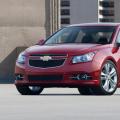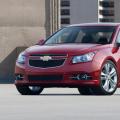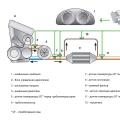The braking maneuver is the most important for safe driving... On the one hand, it allows you to compensate for the consequences of many errors in predicting speed, distance, and the development of the traffic situation. On the other hand, the difficulty of its implementation is one of the main causes of road traffic accidents with serious consequences.
A maneuver designed to improve safety can get out of hand and lead to a loss of stability and control of the vehicle due to wheel locking under heavy braking, especially when the tire grip is low. Driver error can cause a critical skid, drift, rotation and rollover of the vehicle.
The ability to correctly brake includes:
the ability to use maximum grip on the road;
the ability to maintain a straight-line direction of movement when braking;
ability to brake with the engine while shifting gears;
the ability to stop when the brakes fail.
The car decelerates due to the braking forces on the front and rear wheelsoh. On moving car also applies force of inertiaapplied at the center of the car, above the road surface. Under its action, when braking, the front wheels are reloaded, and the rear wheels are unloaded. This can also be seen in the way the suspension and vehicle deform.
Maximum braking force is not determined by how hard you press on the brake pedal. It depends on the load on the wheel and on the adhesion of the wheel to the road. The more the wheel is loaded, the greater the braking force. It is known that the friction at rest (the absence of wheel slip relative to the road) is always greater than the sliding friction. Traction depends on the degree of wheel slip on the surface. The maximum coefficient of adhesion is achieved with a partial slip of 10-15%. And with full slip, the coefficient of adhesion can almost halve. This means that for emergency braking, you cannot bring the wheels to full slip (skidding).
If the wheel is completely blocked (), then the same section of the tire is rubbing on the road surface. At the same time, the rubber wears out in the same way as the eraser with which you remove the pencil line on paper. 06Rubber spools are emitted, on which the locked wheel rolls like rollers. Usually, the beginning of the skid can be judged by the characteristic squeak of rubber sliding on the asphalt. But, firstly, it occurs only on a dry surface, and secondly, it is easy to confuse it with the sometimes squeak in the braking mechanism itself. Other indirect signs of wheel blocking are steering effort and vehicle drift.
In addition, grip depends on the condition of the road surface and how worn the wheel is. So, on wet asphalt, the adhesion is about 2 times less, and on ice - 10 times less than on dry asphalt. Accordingly, the braking force decreases and the braking distance increases.
During braking, the traction force of the wheels in the longitudinal direction is used almost completely. Therefore, a small lateral force is sufficient to cause a loss of lateral traction. This loss of traction occurs earlier on the rear wheels, which are relieved when braking.
Simultaneously with the beginning of the skid, rear wheel skid... You can correct the position of the car by steering. But in order for the vehicle alignment to be effective, stop braking... After leveling the vehicle, you can continue braking again.
Classification of braking techniques
Distinguish service, emergency and emergency braking.
Service braking (with a deceleration rate of less than 3 m / s2) is not associated with a lack of time for decelerating or stopping the car and in normal driving conditions is the most acceptable, since it is carried out in a comfortable zone of negative accelerations.
Emergency braking used in critical situations associated with a lack of time and distance. It implements the most intense deceleration, taking into account the braking properties of the vehicle, as well as the ability of the driver to apply traditional or unconventional techniques, depending on the coefficient of tire adhesion to the road and other external conditions.
Emergency braking used in case of failure or failure of the working brake system and in all other cases when this system does not allow achieving the desired effect.
Impulse braking
Impulse braking includes two ways - intermittent and stepped.
Intermittent braking - periodic pressing of the brake pedal and its complete release. The main reason for the temporary termination of action brakes, is the wheel lock. This method is used on uneven roads and where areas with different traction coefficients alternate, such as asphalt with ice, snow and mud. Release the brake completely before driving over a bump or slippery area.
The effectiveness of the intermittent method during emergency braking is insufficient, since the temporary cessation of the action of the brakes affects the increase braking distance car.
Emergency braking is characterized by stepwise method, which outwardly resembles intermittent, however, unlike intermittent, it does not have a passive phase associated with the complete cessation of the action of the braking mechanisms. It is characterized by a consistent increase in each subsequent effort on the brake pedal, as well as the time of its application. The very first press on the pedal should be extremely short and weak. Overbraking in one of the step braking impulses requires its own compensation, which manifests itself in an increase in the time for unlocking the wheels. In addition, braking with repeated short-term blocking of the wheels requires additional compensation for the stability of the vehicle using steering.
Emergency braking
Appearance in the car ABS, ESP and other driver assistance systems during braking is changing our understanding of what to do during emergency braking. However, for owners of cars that are not equipped ABS, the old recipes are still true.
The intensity of emergency braking is limited by the capabilities of the driver (possession of technical techniques and the ability to maintain stability and controllability of the vehicle), the vehicle (efficiency of braking systems, tire quality) and external conditions (coefficient of adhesion of tires to the road, terrain). In addition to reducing the speed, emergency braking is also inherent in actions that allow you to keep the stability and controllability of the car under control.
Control over the implementation of braking on the verge of blocking the wheels is carried out using the so-called. Different drivers have significant differences in the ability to correct muscle efforts during emergency braking.
Another complicating factor is that it can inhibit the manifestation of even automated motor skills and impair motor coordination. The most pronounced manifestation is inhibition in critical situation with completely locked wheels. It is necessary to suppress this manifestation of reflex activity in the form of dosing effort depending on the speed of the car, the coefficient of adhesion, road surface, motion geometry.
In most cases, the use of emergency braking is associated with the effect of complete or partial short-term blocking of the wheels. Most often, blocking occurs on the rear wheels of the car, since when braking, the load in the car is redistributed along the axes: the front wheels are loaded, and the rear ones are unloaded. Therefore, many cars have special brake force regulators that weaken the effect rear brakes on an unloaded vehicle.
An unconventional method of braking is side slip, which can be realized with a skid of the rear axle, with a drift of all axles or with a rotation of the car.
To transfer the car into a critical skid of the rear axle, instant on / off of the parking brake on the turn arc or shock activation is used downshift ... In this case, the front wheels are controlled (friction at rest), and the rear wheels are not (sliding friction, or). For stable braking in a skid, the driver uses compensatory steering and variable throttling.
Reception is extremely effective on cars with front-wheel drive and allows you to maintain the steering of the front wheels during heavy braking with the service brake, to avoid blocking of the steered wheels, and to increase the braking force. Braking is performed with the left foot, during braking the right leg continues to choke - open choke.
Engine braking and gear shifting
Engine braking does not have much deceleration effect in pure form, therefore, is often ignored by drivers. However, its significance is essential when driving in conditions of low adhesion coefficient and allows to increase the stability and controllability of the car, its stability during emergency maneuvers.
Safe driving requires that any braking technique be performed in a combined way, i.e. with gear engaged... Braking in neutral should be considered frivolous under normal conditions and dangerous under difficult conditions.
Some novice drivers have developed a reflex: when starting to brake, be sure to disengage the clutch. This habit is based on a student's fear of turning off the engine. But the engine stalls at a shaft speed of less than 500-700 rpm. This mode in direct gear corresponds to a speed of 13-15 km / h, therefore, the clutch should be disengaged almost before the car stops.
Reception is performed to equalize the peripheral speeds of rotation of the gears engaged in engagement. This technique helps to avoid a jerk of the car and not to provoke a skid on slippery road and, moreover, reduces wear on synchronizers and increases gearbox service life. In this case, the driver's right foot carries out active braking with the service brake, therefore, in order to perform a rebase, it is necessary to temporarily stop active braking or perform a rebase with the toe (heel) of the right foot without interrupting braking.
Re-gasing during service braking performed in three cycles: turning off the overdrive; pause in neutral position and rebase; engaging a downshift.
Emergency braking requires sequential downshifts from direct to 2nd. The first gear can be engaged in emergency mode in case of failure of the service brake system. In this case, it is desirable to reduce the time for re-gasification and change the structure of the reception. Increasing the speed crankshaft the engine is achieved not by separately pressing the fuel control pedal, but by slowing down the clutch with an open throttle.
For effective braking when driving in 4th gear, simultaneously with the start of braking, switch to 3rd gear... As the vehicle decelerates, as soon as the speed drops to about 70 km / h, change to 2nd gear. However, much depends on the condition of the road surface - for example, in icy conditions or in rain, the maximum braking force in adhesion should be taken into account and not exceeded. Start braking on high speed it is necessary without the use of brakes, only due to engine braking.
To compensate for the dynamic shock that occurs when the downshifts are engaged, some clutch slip is performed. With combined braking, in the event of an emergency deceleration of the vehicle, gear shifting in descending order is carried out at the maximum crankshaft speed, and in some cases at the critical speed.
Gear shifting method may be percussion or soft... The latter method guarantees the stability of the car in difficult driving situations, especially when the coefficient of adhesion of the tires to the road is low, but requires a high level of skill.
Four actions are performed almost simultaneously: the right hand changes gear, the left hand corrects the trajectory with the steering wheel, the right foot provides braking and rebounding, the left hand disengages and engages the clutch.
Selectivity is very harmful: on a dry road, brake only with a working brake, on a slippery road - also with a motor. It is much safer to have a developed skill of mixed braking and apply it in any conditions than to create a braking stereotype for yourself and, due to the existing automatism, apply it on ice or snow.
Emergency braking
Emergency braking can be carried out parking brake , and in unconventional ways, including the contact method using natural and artificial obstacles.
In an emergency, when all possibilities for an emergency maneuver have been exhausted and / or the braking system has failed, most drivers stop driving due to inability and stress. However passive safety the design of a modern car can significantly reduce the severity of the consequences of an accident due to deformation of crumpled body parts, such as fenders, bumpers, trunk.
In this case, it is important to choose the direction of contact in order to avoid impact, since of all the power elements of the body, the side members have the maximum longitudinal stiffness, reach into the oncoming lane and overturn. Both the driver and passengers need to be able to quickly adopt a safe posture to reduce the effects of an impact.
It is impossible to simultaneously perform sharp braking (to the skid) and maneuvering... Suppose the car is traveling in a straight line at 60 km / h. Hard braking, and then - turn the steering wheel. Result: The vehicle maintains a straight track. The front wheels are locked, but the rear wheels are not (thanks to the pressure regulator). The car is uncontrollable, but does not rotate around the vertical axis. If you perform the same sequence of actions, but at the end remove your foot from the brake, then a sharp jerk of the car occurs in the direction of the steering wheel. When the brake pedal was released, the front wheels changed from sliding friction to static friction, traction, and the car to an inverted steering wheel.
If, during heavy braking, you do not have time to disengage the clutch at the end, the engine will stall, which in turn will also turn off the vacuum brake booster and power steering. In such a situation, there is only one way out: without disengaging the clutch and remaining in the same gear in which the car stalled, continue braking, pushing the brake pedal. At the same time, you should not be afraid of locking the front wheels, since the effort on the brake pedal will be unusually large and most likely there will be underbraking. There is simply no time to restart, and the vacuum and hydraulic units will come into working condition only a couple of seconds after starting.
With a contrastingly changing coefficient of adhesion (ice-asphalt), it is advisable to time the braking force to an area with favorable conditions for braking.
When braking on a road surface with unevenness, it is desirable to stop braking when overcoming them.
Brakes may overheat on long descent... Temporarily stopping braking allows you to maintain optimal temperature regime the working brake of the car, and therefore its effectiveness.
Try to brake smoothly under normal conditionsby adjusting the force of pressing the brake pedal depending on the speed of movement - the lower the speed, the weaker the pressure on the pedal.
Look in your rearview mirror before braking..
Disengage the clutch just before stopping the car..
In a safe environment (or better with an instructor) practice your skills: impulse braking; engine braking; re-gasing.
Correct the trajectory of the vehicle when braking by the steering wheel... To compensate for skidding of the rear wheels, stop braking, straighten the trajectory of the car, and then continue braking.
Unload the front suspension at the end of braking in front of an obstacle... If you cannot stop completely, you must force yourself to release the brake pedal just before the obstacle. Then the impact will be on the unloaded suspension, which will reduce the likelihood of breakage. Responsive drivers can further relieve the suspension by quickly pressing on the accelerator while the front wheels are overcoming an obstacle.
Emergency braking before a sudden obstacle is one of the most dangerous and unpredictable maneuvers performed by driver on the road. This measure is used only in extreme cases, and requires high professional qualities and knowledge from the person driving! how perform emergency braking correctly, in a timely manner to stop a car rushing towards the impact, avoid a serious accident?
Standard brake receptionused by most drivers in emergency situation
, consists in a sharp and strong pressure on brake pedal... Unfortunately, this method almost always calls a complete wheel lock... The car starts to slide on the asphalt with minimal deceleration dynamics. In addition, it is also completely loses control, since at locked wheels the reaction of the car to the actions of the wheel is practically absent. Avoid an accident in such cases only a few succeed!
Today, motorsport specialists and instructors extreme driving a variety of techniques have been developed to significantly shorten braking distance car at emergency braking... Below we will consider those that are available for execution by a simple motorist who does not have special training.
Intermittent braking
This technique is based on the maximum possible reduction of the wheel blocking time. It is performed as follows. Brake pedal when braking, they press quickly and sharply. At the first sign of slipping, the pedal is fully or almost completely released, allowing the wheels to catch the road again. After this action is repeated with the brake pedal. The brake operation episodes are repeated at the maximum speed possible for a particular driver.
The effectiveness of this technique is based on the fact that the maximum deceleration rate is reached at the moment when braking occurs on the verge of stalling into a skid. It is important to remember that you should not place the gear shift lever in neutral. Some thrust reserve serves as an additional anti-lock braking measure, and also allows accelerate sharply if necessary.
Impulse braking
Impulse braking is a slightly more effective emergency stop technique vehiclethan intermittent. At the same time, impulse braking is much more difficult to perform. It is performed with the help of sharp and quick clicks on brake pedal, but without completely separating the leg from it. Thus, briefly pressing the pedal and feeling wheel lock, the driver only needs to weaken the braking force, and not completely eliminate it. The thrust of the engine will allow the wheels to spin and catch the road, but the car will continue to slow down.
Release the brake pedal only when reaching wheel slip... An earlier release of braking forces will significantly reduce the effect of using this counter-emergency reception.
Gas plus brake
Perhaps the simplest technique available to almost all drivers is braking by simultaneous pressing gas and brake pedals. At the same time, the driver's left foot applies the brake, and the right foot applies the gas. Reception is carried out when the transmission is on.
Similar combined braking allows you to quickly reduce the speed even for inexperienced drivers who are not able to quickly operate the brake pedal. The principle of its effective operation is that a running engine generates some torque that does not allow the wheels to slip into skid.
Side slip
Experienced drivers braking is also available side slip... Moreover, using hand brake , or turning the wheels with the creation of excessive traction, the car is deliberately and set sideways relative to the road. Side slip is an excellent inertia damper that allows you to quickly stop the car... It must be remembered that this technique is not recommended for drivers who do not have a lot of driving experience and a good sense of the car.
Contact braking
Contact braking represents car stop by contacting it with any large road object (another car, fence). Contact must be performed tangential... This will allow avoid serious damage vehicle and injury to people in it.
Contact braking is an last resort, and should only be used in cases where other techniques emergency stop The vehicles are no longer able to provide the required deceleration rate.
To never fall into emergency situations, you need to constantly predict the traffic situation. But if a person, like a computer, could accurately analyze and predict, he would not waste time standing in traffic jams, but would sit all his free time in bookmakers, making winning bets. It is impossible to calculate everything, because every driver is simply obliged to learn "not to brake" when it is necessary to correctly brake.
Every day, we, a proud caste of motorists, unknowingly practice standard braking techniques. And even if we once had emergency braking skills, they are gradually forgotten and lost forever. However, this state of affairs should not suit a person who cares about safety.
You need to face the truth - the majority of drivers have no idea how they will behave vehicle in the event that there is a need for emergency braking. Meanwhile, each car can boast of its own unique response to such radical driver actions. And it's not even about the car model, because even representatives of one lineup due to their specifics and characteristics, they will react to hard pressing brake pedals in their own way. So if you want  you know exactly what trick your pet can throw out during emergency braking, the only way to find out is to exercise.
you know exactly what trick your pet can throw out during emergency braking, the only way to find out is to exercise.
It is best to go around, or rather slow down, your swallow on an empty road. This should be done in several stages.
Start at 30 km / h and then increase the speed by 10 km / h after each break experiment. Keep an eye on your car and memorize its behavior so that later you know which stirrup to pull.
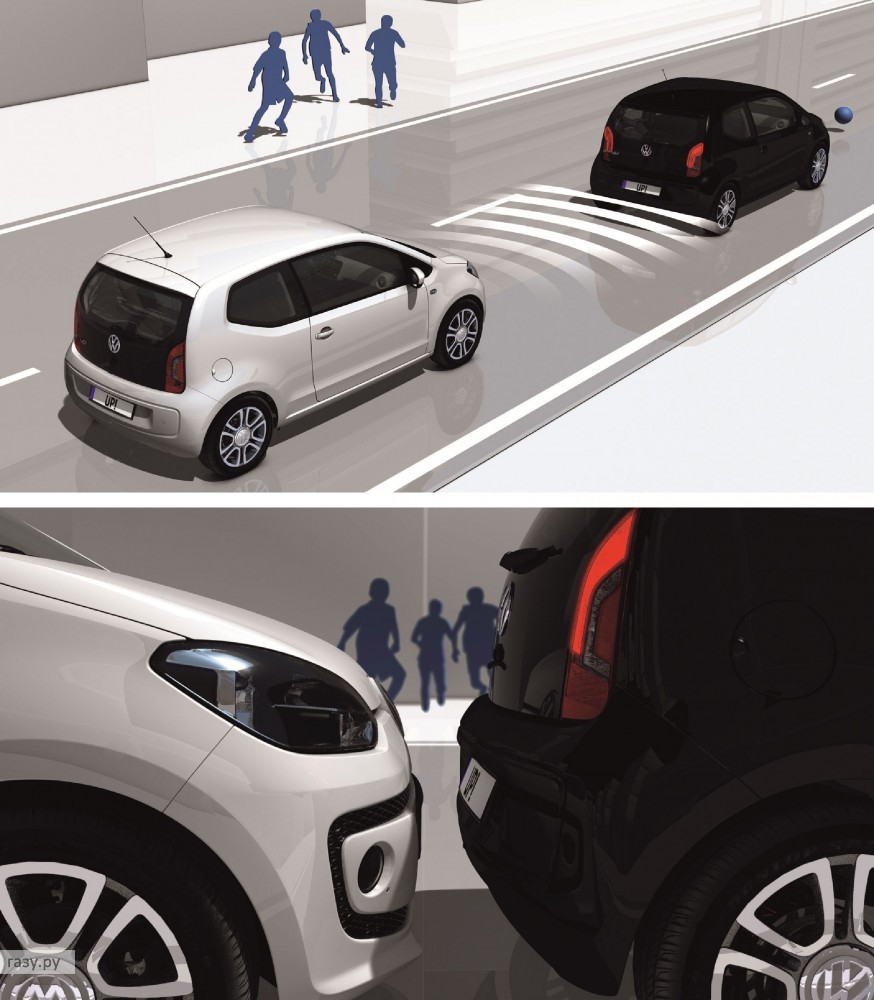 Common mistakes.
Common mistakes.
Many drivers interpret the very concept of "emergency braking" literally. However, in reality, you need to brake urgently, balancing on the edge when the wheels are completely blocked. When the wheels are completely locked, the car skids, and as a result, it drifts. At the same time, the braking distance increases significantly. Even experienced drivers make this mistake - they sharply press the brake pedal to the floor and hold it in such a “strangled” position.
Advice... In order to completely stop the car in an emergency, you need to apply only the initial effort to the brake pedal, and then strongly and fairly quickly fully depress the brake until the wheels are completely locked. After that, it is necessary to release the pressure on the pedal to prevent skidding, and then block the wheels again. And so several times, alternating their actions. This is the so-called impulse braking, in which it is easiest to control the movement of a car that is about to break into a skid.
High-end riders are able to perform about 12 movements in just one second, acting on three pedals, the gear lever and the steering wheel, while working with their right foot to brake with a frequency of about eight impulses per second. Experts have calculated that the pros have about 150 techniques and braking elements in stock that they can apply in a given situation: this is lateral slip braking, and controlled rotation, and controlled skid and even contact braking, when there is nothing else left. how to use a roadside post as a brake.
In case of emergency braking, the condition of the road surface should also be taken into account - the choice of the course of action will depend on its characteristics.
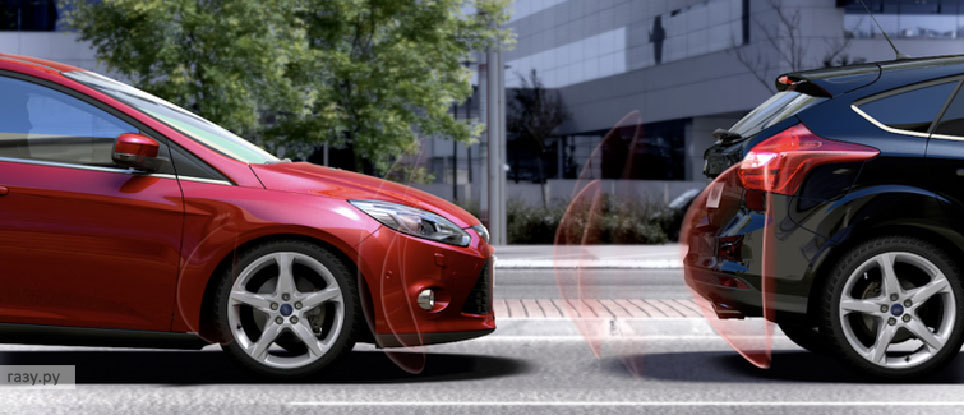
Timely braking is a huge money saving ....
On dry asphalt.
In this case, you need to slow down exclusively on the verge of entering the skid. Press firmly on the brake, and then release it smoothly, reducing the speed. This will keep the vehicle close to demolition.
During rain or ice.
To begin with, you need to press the brake pedal rather shortly and lightly, and then gradually increase the braking force and the time of pressure on the brake. If the road is too slippery, you can help yourself with the engine - brake, downshifting.
Snowy road.
Professionals argue that in this case the most effective way braking is complete blocking of the wheels. Rollers of snow are formed in front of completely locked wheels, which serve as an additional means of braking.
Emergency braking with ABS
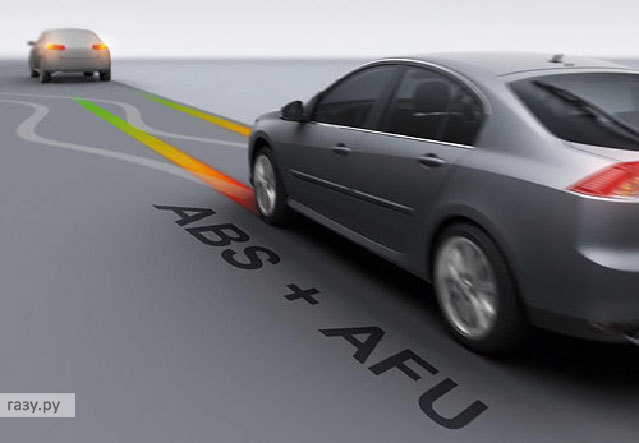 In the case of an anti-lock braking system, it is necessary to "shock" the brake pedal. A strong and precise impact allows the ABS to fulfill its full potential. The anti-lock braking system sends braking force to each wheel about 15 times per second. Thanks to this, the braking distance is significantly reduced, and the driver, as before, can control the car without any problems and change its trajectory using the steering wheel. Some modern cars equipped with a system called Brake Assist - this car "gadget" allows you to recognize those situations when the driver presses the brakes in a panic, and helps him to cope with an emergency.
In the case of an anti-lock braking system, it is necessary to "shock" the brake pedal. A strong and precise impact allows the ABS to fulfill its full potential. The anti-lock braking system sends braking force to each wheel about 15 times per second. Thanks to this, the braking distance is significantly reduced, and the driver, as before, can control the car without any problems and change its trajectory using the steering wheel. Some modern cars equipped with a system called Brake Assist - this car "gadget" allows you to recognize those situations when the driver presses the brakes in a panic, and helps him to cope with an emergency.
Common mistakes.
Many drivers do not grip the steering wheel firmly enough during a sudden decrease in speed. Uneven load on the wheels, as well as unevenness in the road, can provoke a situation where the steering wheel simply breaks out of the hands. As a result, the car "rests" in the ditch, and the driver nervously smokes a second cigarette with the filter torn off. And only then he realizes that he is a non-smoker.
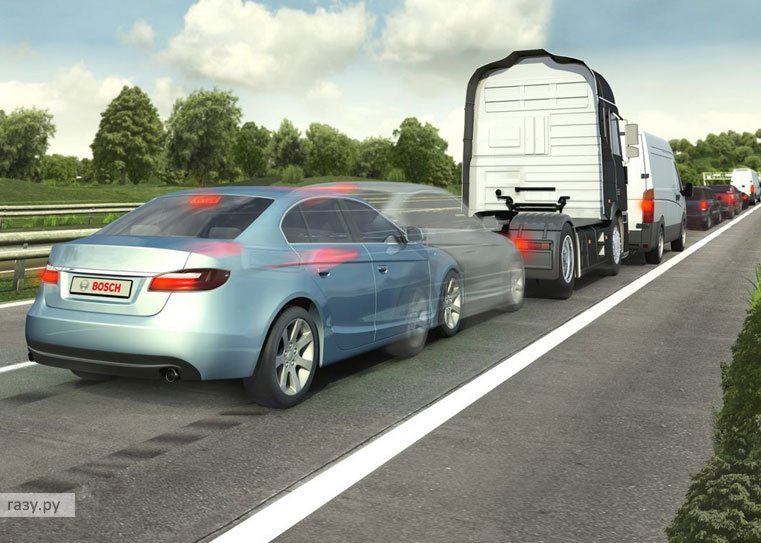
If the distance is maintained, emergency braking is not required
Advice
- During emergency braking, special attention should be paid to landing: you need to snuggle closer to the seat, which will make it possible to feel in time the moment when the car loses stability.
- Keep both hands symmetrically in the upper section of the steering wheel at all times so that you can react immediately when the car skids.
- Always make sure that the tires do not resemble Gosha Kutsenko's head.
And the benefits that it gives the driver. How to use correctly anti-lock braking system? How to brake properly on a car without ABS? We will discuss these questions ...
How to brake properly with ABS?
It's very simple, you just need to follow two rules:
In short, for emergency braking, you need to sharply hit the brake pedal and keep it pressed until the vehicle comes to a complete stop or until the required speed reduction.
Depress the clutch pedal?
Another important question: should you depress the clutch pedal when braking with ABS and manual transmission? The instructions for foreign cars say "squeeze". In general, this is not so important. The only difference is that when braking with the gear engaged, you need to apply the brake more to achieve maximum deceleration than when the clutch pedal is depressed. But, believe me, the brakes are so strong that they will cope with their task in both cases. So it's up to you to squeeze out the clutch, but you should know the pros and cons of both braking methods. And they are as follows.
Breaking driver's templates is not good ...
If in everyday driving you are used to braking in a engaged gear without squeezing the clutch pedal (which is very correct!), Then squeezing it out during emergency braking means doing an unnecessary action, breaking the template. This is not good: in an extreme situation, the fewer choices the better. Otherwise, the brain may "jam", and either time will be wasted on choosing the appropriate option for braking (or any other action, this applies not only to braking), or, in the worst case, it may not be possible to press the brake at all ...
A stalled motor is even worse
If you do not depress the clutch pedal, or rather, depress it only before the moment the car stops, there is a risk of turning off the engine. After all, during emergency braking, any driver's thoughts about what? How to avoid a collision, not how to depress the clutch pedal in time. There is no crime in this, but there is not enough good either. After all, when the engine turns off, and you will not be able to accelerate if necessary. What for? You never know, suddenly you had time to slow down, and the driver could not keep up with you? In general, braking is such a thing, which is often followed by acceleration, and an engine is sometimes needed.
How to brake without ABS?
But what if there is no ABS in the car or it is faulty? The end goal is the same: to achieve braking on the verge of locking the wheels. Only in the absence of ABS your task is complicated by the fact that you need to accurately dose the effort on the brake pedal. And the required pedal effort will vary greatly in different driving conditions. For example, on snow, wheel blocking will occur with a noticeably weaker brake pressure than on asphalt. Likewise, it is much easier to skid an empty car than a loaded one. If the gearbox in the car is mechanical, then when braking in neutral or with the clutch pedal depressed, the wheels will be locked when the brake is pressed less than when the gear is engaged. Etc. therefore when braking without ABS, it is almost impossible to correctly guess the effort from the first pressing of the pedal... Moreover, we are talking about emergency braking, when all the thoughts and feelings of any normal person driving will be about how to avoid a collision, and not about the effort on the pedals.
Sports braking and emergency braking
However, professional riders succeed in this, but as a result of many years of training. Yes, and they still slow down before the turns well known to them, and not in front of a child who suddenly ran out onto the track ... So it is possible to feel the edge of tire slip during braking, but either in theory or during training on a closed circuit, and hardly in an extreme situation on the road. Therefore, it is correct to divide sports braking - with maximum intensity, but planned and not associated with the avoidance of an accident, and emergency braking - unplanned and aimed at avoiding an accident. That is, from the point of view of physics, these two types of inhibition, it would seem, are identical, but from the point of view of psychology and physiology, they are fundamentally different.
Impulse braking - sports braking
One way to “be on the edge” is by impulse braking. It reminds aBS work and sometimes this technique is even called an imitation of the ABS, although historically the ABS appeared later, just to replace impulse braking. Therefore, it is more correct to say that the ABS imitates the driver's actions during impulse braking.
The essence of the technique is that after the wheels start blocking, you immediately release the pressure on the brake pedal so that the wheels begin to rotate again. Then you repeat the described cycle of actions, as a result of which the braking looks like an impulse one. Reception is the more effective the more often the driver presses the brake pedal. It is recommended to do 3-4 clicks per second. But this technique has its pros and cons. Pros: intense deceleration, minimal risk skidding. And the lack of impulse inhibition is one and very significant: this method runs counter to human physiology... Any normal person in an extreme situation puts the brake on the floor, and there is little that can make him relax. To feel the correctness of this statement, imagine: you have a woman with a stroller on your way, you press the brake pedal as hard as you can and suddenly remember about impulse braking (although you can hardly remember, but let's say). Do you think you can take your foot off the brake pedal?
Dosed braking on the edge - sports braking
Another way of braking on the edge of tire adhesion is conventional braking, in which the driver moves the pedal exactly to the position that corresponds to the edge of wheel locking, that is, maximum deceleration. It would be nice to brake the driver in such a way in extreme situations, but it is hardly possible psychologically. Again, in a state of shock from the fact that your car "flies" on a person, it is impossible to dose the effort on the pedals. The foot will automatically rest against the brake pedal, move it to the floor, and the car will go skidding. However, this edge-braking trick is great for riders. So you can brake before turning on the tracks, when every braking is planned and without the shock of an impending accident.
Even Schumacher in an extreme situation brakes with a skid!
As an illustration of the above, I will give the following example. In 2011, at the Formula 1 Singapore Grand Prix, Michael Schumacher had an accident. His car flew over the track, landed, and then went straight to the bump stop. Here is a video, watch from the 42nd second:
Pay attention to the marks after braking - black and continuous. Conclusion? Michael Schumacher (Schumacher !!!) stupidly pressed the brake to the floor. Although he is one of the oldest and most experienced racers, 7-time world champion in Formula 1, and better than others, he knows how to brake on the edge of sliding. Moreover, it is known that skid braking in Formula is considered a gross mistake, since it increases the lap time and kills the tires. Why did he slow down with a skid? Only he himself can answer this question exactly, but my considerations are as follows. It's simple: Michael did not slow down before the next turn, everything was coldly calculated and prepared. He braked as a result of an unexpected collision and understood the inevitability of another collision in the next few seconds. He was frightened, did not expect, the situation took him by surprise. As a result, uncontrollably pressed the brake, which led to skidding.
What does this mean for you and me? Even if Schumacher cannot control himself in really dangerous situations and dose the effort on the brake pedals, what is left with you? What other braking on the brink ???
Actually, I will say this. If suddenly something works inside a driver flying at a person and he releases the brake for a second in order to straighten the car and steer - not bad. I admit that this is possible. But counting on this is wrong. It is correct to prepare for the fact that in such a situation the leg will rest on the brake and no force can no longer lift it from there. And if suddenly it has risen, it means that a rare exception to the iron rule has been realized: in a dangerous extreme situation, the driver brakes to the floor.
Skid braking - emergency braking
- This is physiological!
- The car may not be as intense as possible, but it will still slow down. Just think, the slowdown will not be 100%, but 90 - does it matter, especially when there is no choice?
- Yes, it is impossible to steer, but there is nothing to be done, but the stopping distance in a straight line is always shorter than with maneuvering.
- Yes, the car can skid and twist along the road, but this is not scary, because when braking by "skid" the car moves exactly in a straight line. I mean, it can spin and rotate around its axis as it pleases, but all this will happen along a straight line
If you start to brake along the road, then stop along the road too. And then, the main task is to stop the car before the obstacle, and not stop it, for example, strictly at an angle of 90 degrees to the obstacle. So let it rotate, if only to avoid an accident!
- And one more nuance - if the car slides on the road, then the braking distance during rotation is always shorter than in a straight line. After all, those, say, 40 meters of stopping distance in a straight line will curl into a spiral, which will be the same 40 meters long, and will take much less space on the road. As well as a kilometer-long thread you can fit in a pocket in the form of a ball.
Don't believe me? Come to emergency training courses, try it and see for yourself!
Depress the clutch pedal?
When braking without ABS, the risk of turning off the engine does not arise before stopping, as with ABS, but at the very beginning of braking. After all, locked - stopped wheels, connected to the engine by a gear, stop it ... Especially on a slippery road, when braking "to the floor" in gear, the motor stalls in a moment. And subsequent attempts to accelerate may fail. In addition, when the engine is turned off, the brake and steering booster is turned off, which complicates the control of the machine.
therefore in case of emergency skid braking, depress the clutch pedal immediately - at the beginning of braking.
Emergency braking. Outcome
Well, let's summarize on the topic of emergency braking.
1. ABS provides the following benefits in emergency braking:
- you do not need to think about how to brake and measure the effort on the brake pedal;
- you can change the trajectory of the car;
- you will avoid skidding and rotation of the car, especially when there are sections of the road of different "slipperiness" under the wheels on the right and left.
2. For emergency braking with ABS, the following rules must be observed:
- you must press the brake pedal hard enough to activate the ABS;
- you must press the pedal quickly, sharply, briskly in order to activate the ABS as quickly as possible;
- keep the brake pedal depressed until the vehicle comes to a complete stop.
3. If your machine mechanical box gears, then depress the clutch pedal during emergency braking.
4. When braking on a vehicle without ABS, note the following:
- the maximum deceleration of the car is achieved precisely on the verge of sliding tires on the road, and it does not matter in what way - with or without ABS.
- it is almost impossible to correctly guess the effort from the first pressing of the pedal
- the lack of impulse or dosed inhibition is one and very significant: this method runs counter to human physiology
therefore, brake on a car without ABS in the same way as with ABS: brake to the floor!

